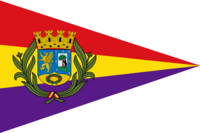| Distintivo de Madrid | |
|---|---|
 Pennant | |
| Type | Badge |
| Awarded for | Valour |
| Presented by | the Spanish Republic |
| Eligibility | Ships and Navy personnel |
| Status | Awarded 1938–1939 |
| Established | 23 January 1938 |
The Madrid Distinction (Spanish : Distintivo de Madrid) was one of the highest military awards of the Second Spanish Republic. It was a decoration related to the Laureate Plate of Madrid. [1] which was established by the Second Spanish Republic in order to reward courage. [2] In the same manner as the Laureate Plate it was named after Madrid, the capital of Spain, owing to the city symbolizing valour and the defence of the Spanish Republic during the long Siege of Madrid throughout the Spanish Civil War. [3]